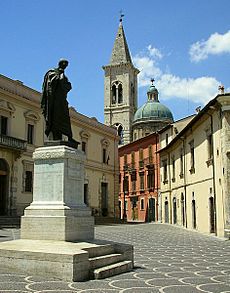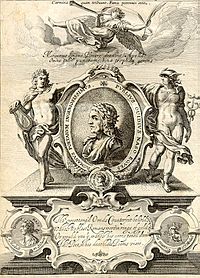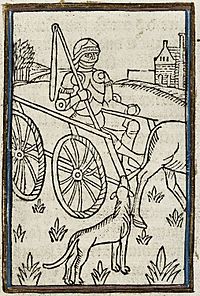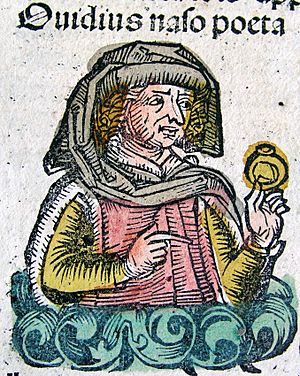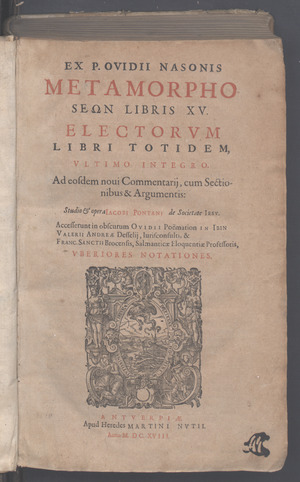Ovid facts for kids
Quick facts for kids
Ovid
|
|
|---|---|
 |
|
| Born | Publius Ovidius Naso 20 March 43 BC Sulmo, Italy, Roman Republic |
| Died | 17 or 18 AD (age 59–61) Tomis, Scythia Minor, Roman Empire |
| Occupation | Poet |
| Genre | Elegy, epic, drama |
| Notable works | Metamorphoses |
Publius Ovidius Naso (born March 20, 43 BC – died 17 or 18 AD), known as Ovid, was a famous Roman poet. He lived during the time of Emperor Augustus. Ovid is often considered one of the three most important Latin poets, along with Virgil and Horace.
Ovid was very popular during his life. However, Emperor Augustus sent him away to Tomis. This was a far-off province on the Black Sea. Ovid stayed there for about ten years until he died. He said his banishment was because of "a poem and a mistake."
Contents
About Ovid's Life
Ovid wrote more about his own life than most other Roman poets. We learn about him mostly from his poems. One poem, Tristia 4.10, tells a lot about his life.
His Early Life and Family
Ovid was born in a town called Sulmo (today's Sulmona, Italy). This was on March 20, 43 BC. His family was important and wealthy.
Ovid and his brother studied public speaking in Rome. His father wanted him to become a lawyer. But Ovid was more interested in writing poetry. After his brother passed away at age 20, Ovid gave up law. He traveled to Athens, Asia Minor, and Sicily.
He held a few small public jobs. But he quit them to become a poet around 29–25 BC. His father was not happy with this choice.
Ovid gave his first poetry reading when he was about 18. He became friends with other poets like Propertius and Horace. He also admired Tibullus.
Ovid was married three times. He had one daughter and grandchildren through her. His last wife came from an important family. She helped him during his time in exile.
Ovid's Literary Success
For the first 25 years of his writing career, Ovid mainly wrote love poems. His first known work is thought to be the Heroides. These are letters from famous mythological heroines.
His collection of love poems, Amores, was published around 16–15 BC. It was later shortened to three books. Ovid also wrote a play called Medea, which was popular but is now lost.
Ovid's poem Ars Amatoria (The Art of Love) was published around 2 AD. It was a guide about love and relationships. Ovid later said this poem was one reason for his banishment. This poem was followed by Remedia Amoris (Remedies for Love). These works made Ovid one of the top Roman love poets.
By 8 AD, Ovid finished his most famous work, Metamorphoses. This is a long poem in 15 books. It tells many stories from Greek and Roman mythology. All the stories are about transformations, where people or things change into new forms.
At the same time, he was working on the Fasti. This was a six-book poem about Roman festivals and astronomy. He had to stop writing this poem when he was sent away.
Ovid's Exile to Tomis
In 8 AD, Emperor Augustus banished Ovid to Tomis. This was a city on the Black Sea. Ovid wrote that he was exiled because of "a poem and a mistake." He said his crime was worse than murder.
Around the same time, the Emperor's grandchildren were also sent away. One of them, Julia the Younger, had a husband who was put to death for plotting against Augustus. Ovid might have known about this plot.
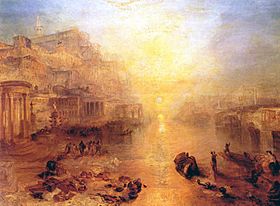
In exile, Ovid wrote two poetry collections: Tristia and Epistulae ex Ponto. These poems show his sadness and loneliness. He was far from Rome and couldn't access libraries. He even learned the local languages, Sarmatian and Getae.
The five books of Tristia were written between 9–12 AD. They express his despair and hope to return to Rome. The Epistulae ex Ponto are letters to friends in Rome. He asked them to help him return. These were his last poems, written between 13 and 16 AD.
Ovid missed Rome very much. He wrote many poems to his third wife, to Emperor Augustus, and to his friends. He expressed his loneliness and hope for a recall from exile.
The exact reasons for Ovid's exile are still a mystery. Ovid himself gave unclear clues. Most scholars believe he was truly exiled. They argue that he wouldn't have left his important poem Fasti unfinished if it were just a story.
Ovid's Death
Ovid died in Tomis in 17 or 18 AD. It is believed that his poem Fasti was published after his death.
Ovid's Famous Works
Heroides ("The Heroines")

The Heroides is a collection of 21 poems. They are written as letters from famous mythological women to their partners. These letters show the women's feelings about being separated from their loved ones. They also ask for their partners to return.
The first 14 letters are from heroines like Penelope, Dido, and Medea. The last six letters are paired, with a letter from a lover and a reply. For example, there are letters between Paris and Helen.
These letters show Ovid's skill in creating deep psychological portraits of mythical characters. They also explore how gender and identity were seen in ancient Rome.
Amores ("The Loves")
The Amores is a collection of three books of love poems. Ovid changed the usual style of love poetry. Instead of focusing on the poet's triumphs, he focused on the triumphs of love itself.
The poems describe many parts of love. They focus on the poet's relationship with a woman named Corinna. The poems tell different stories and events in their relationship.
- Book 1 has 15 poems. The first poem tells how Ovid wanted to write epic poetry. But Cupid made him write love poems instead.
- Book 2 has 19 poems. It includes a lament for Corinna's dead parrot. It also tells about Ovid's affair with Corinna's servant.
- Book 3 has 15 poems. It describes a visit to the races and Corinna's interest in other men. In the end, Ovid decides not to love Corinna anymore.
These poems are known for being very clever and playful.
Medicamina Faciei Femineae ("Women's Facial Cosmetics")
Only about 100 lines of this poem survive. It is about beauty treatments for women's faces. The poem suggests that good manners are most important. Then it gives recipes for facial treatments.
Metamorphoses ("Transformations")
The Metamorphoses is Ovid's most famous work. It is a long poem with 15 books. It tells nearly 250 different myths from Greek and Roman mythology. The word "metamorphoses" means "transformations." In the poem, characters often change into new forms like trees, rocks, animals, or flowers.
- Book 1 describes how the world was formed and the different ages of humans.
- Book 3 focuses on the myths of Thebes, like the stories of Cadmus and Actaeon.
- Book 4 tells about three pairs of lovers: Pyramus and Thisbe, Salmacis and Hermaphroditus, and Perseus and Andromeda.
- Book 8 includes Daedalus' flight and the story of Baucis and Philemon.
- Book 10 tells sad love stories, like Orpheus and Hyacinthus.
- The final book ends with the praise of Emperor Augustus. Ovid believed his poem would make him immortal.
Scholars admire how Ovid organized so many myths. He linked stories by place, theme, or contrast. This makes the reader think about the connections between them.
Fasti ("The Festivals")
Six books of this poem still exist. Ovid was working on it when he was exiled. The six books cover the first half of the year, from January to June. Each book is about a different month of the Roman calendar.
The poem explains the origins and customs of important Roman festivals. It also includes mythical stories and information about astronomy and farming. Ovid probably planned to cover the whole year. But his exile stopped him from finishing it.
Tristia ("Sorrows")
The Tristia is a collection of five books of poems. Ovid wrote them while he was in exile in Tomis.
- Book 1 describes Ovid's last night in Rome and his journey to Tomis.
- Book 2 is one long poem where Ovid defends himself and his poetry. He asks the emperor for forgiveness.
- Book 3 focuses on Ovid's life in Tomis. It describes his book arriving in Rome to find his works banned. It also shows his sadness and longing for home.
- Book 4 has poems mostly addressed to friends. Ovid expresses his love for poetry and how it comforts him.
- The final book focuses on his wife and friends. Ovid asks for letters and apologizes for the quality of his poetry.
Epistulae ex Ponto ("Letters from the Black Sea")
The Epistulae ex Ponto is another collection of four books of poems from exile. Each poem is addressed to a different friend. Ovid desperately asks his friends to help him return from exile.
The poems talk about his health, his hopes, and his memories of Rome. He also describes his life in exile. He asks friends to speak to the imperial family on his behalf.
Ovid's Poetic Style
Ovid is known as the last important love poet of his time. He was very creative in how he used the rules of love poetry. Unlike other poets, Ovid seemed more distant from his love interest. This led scholars to believe that his character Corinna was not a real person.
Ovid was very inventive. He used traditional poetic ideas in new ways. He also created new types of poems. His love poems cover many themes and viewpoints. For example, the Amores focuses on his relationship with Corinna. The Heroides tells stories of mythical characters in love. The Ars Amatoria gives advice on relationships.
Ovid's writing style was influenced by his education in public speaking. This can be seen in how he lists things, creates surprises, and smoothly moves between ideas.
Ovid's Lasting Influence
How Ovid's Work Was Seen
Ovid's works have been understood in different ways over the centuries. Even during his lifetime, he was famous but also criticized. He responded to critics by saying his fame would only grow.
During the Middle Ages and the Renaissance, Ovid became one of the most loved Roman poets. Writers used his work to explore stories of violence. A French work called Ovide moralisé retold 15 books of the Metamorphoses. This influenced writers like Geoffrey Chaucer.
Ovid's poetry also inspired the idea of humanism. Many Renaissance painters and writers were influenced by him. For example, William Shakespeare and Christopher Marlowe were inspired by his works. Miguel de Cervantes also used the Metamorphoses for his novel Don Quixote.
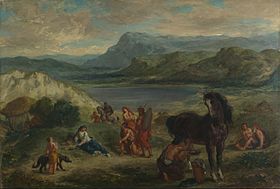
In the 16th century, some of Ovid's love poems were even burned in England. This was because some people thought they were immoral. The Puritans later saw Ovid as pagan and a bad influence.
In the 19th century, the Romantic movement didn't like Ovid's poems as much. They thought his poems were too formal and lacked real emotion. However, they might have preferred his exile poetry.
The painting Ovid among the Scythians by Eugène Delacroix shows Ovid's last years in exile. This painting influenced artists like Charles Baudelaire. It shows how Ovid's exile connected with Romantic ideas of wildness and misunderstood genius.
In recent years, Ovid's exile poems have become more popular among scholars.
Ovid's Impact on Arts and Literature
Ovid's works have had a huge impact on literature and art throughout history. Here are some examples:
- (12th century) Medieval love stories were influenced by Ovid.
- (13th century) Dante Alighieri was influenced by Ovid.
- (14th century) Poets like Petrarch and Geoffrey Chaucer were inspired by Ovid.
- (15th century) The painter Sandro Botticelli used Ovid's stories.
- (16th–17th century) Playwrights like William Shakespeare and Christopher Marlowe used Ovid's myths.
- (17th century) John Milton and Miguel de Cervantes were influenced by Ovid.
- (1820s) Russian poet Alexander Pushkin compared himself to Ovid during his own exile.
- (1916) James Joyce's novel A Portrait of the Artist as a Young Man includes a quote from Metamorphoses.
- (1960s–2010s) Singer-songwriter Bob Dylan has used Ovid's words and ideas in his songs.
- (1971) The band Genesis's song The fountain of Salmacis tells a myth from Metamorphoses.
- (1978) Australian author David Malouf's novel An Imaginary Life is about Ovid's exile.
- (2002) A play called Metamorphoses by Mary Zimmerman was performed, based on Ovid's work.
- (2015) In the TV show The Walking Dead, a Latin phrase from Ovid is used: "Dolor hic tibi proderit olim" (meaning: "This pain will be useful to you someday").
Dante mentioned Ovid twice in his famous works. He called Ovid one of the four "regular poets."
Retellings and Adaptations of Ovid's Works
Many artists have retold, adapted, or translated Ovid's stories:
- (1609) The Wisdom of the Ancients by Francis Bacon retells Ovid's fables.
- (1767) Apollo et Hyacinthus, an early opera by Wolfgang Amadeus Mozart.
- (1926) Orphée, a play by Jean Cocteau, retells the Orpheus myth from Metamorphoses.
- (1938) Daphne, an opera by Richard Strauss.
- (1997) Tales from Ovid by Ted Hughes is a modern poetic translation of passages from Metamorphoses.
- (2000) Ovid Metamorphosed, a collection of short stories retelling Ovid's fables.
- (2013) Ovid's Heroines by Clare Pollard is a new poetic version of Heroides.
Images for kids
-
Ovid by Luca Signorelli.
-
Scythians at the Tomb of Ovid (c.1640), by Johann Heinrich Schönfeld.
See also
 In Spanish: Ovidio para niños
In Spanish: Ovidio para niños
- Cultural influence of Metamorphoses
- List of characters in Metamorphoses
- Metamorphoses (2014 film)
- Ovid Prize
- Prosody (Latin)
- Sabinus (Ovid)
- Tragedy in Ovid's Metamorphoses


